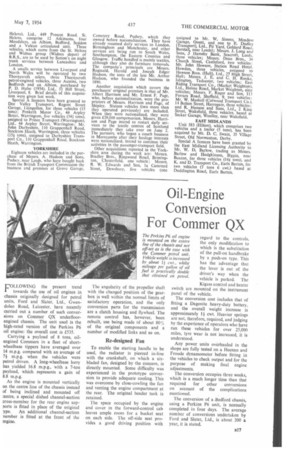Oil-Engine Conversion For Commer QX
Page 63

If you've noticed an error in this article please click here to report it so we can fix it.
FOLLOWING the present trend towards the use of oil engines in chassis originally designed for petrol units, Ford and Slater, Ltd., Gwendolen Road, Leicester, have recently carried out a number of such conversions on Commer QX underfloorengined chassis. The unit used is the high-rated version of the Perkins P6 oil engine: the overall cost is £535.
Carrying a payload of 8 tons, oilengined Commers in a fleet of shortwheelbase tippers have averaged over 14 m.p.g. compared with an average of 71 m.p.g. when the vehicles were petrol driven. A long-wheelbase lorry has yielded 16.8 m.p.g., with a 7-ton payload, which represents a gain of 8.8 m.p.g.
As the engine is mounted vertically on the centre line of the chassis instead of being inclined and mounted off :entre, a special dished channel-section cross-member for the rear engine sup7orts is fitted in place of the original ype. An additional channel-section nember is fitted at the front of the
The angularity of the propeller shaft with the changed position of the gearbox is well within the normal limits of satisfactory operation, and the only conversion parts for the transmission are a clutch housing and flywheel. The remote control has, however, been rebuilt, use being made of about 80% of the original components and a number of modified links and so on.
Re-designed Fan To enable the starting handle to be used, the radiator is pierced in-line with the crankshaft, on which a sixbladed fan, designed by the concern, is directly mounted. Some difficulty was experienced in the prototype conversion to provide adequate cooling. This was overcome by close-cowling the fan and venting the engine compartment at the rear. The original header tank is retained.
The space occupied by the engine and cover in the forward-control cab leaves ample room for a bucket seat on each side. The off-side seat provides a good driving position with
regard to the controls, the only modification to which is the substitution of the pull-on handbrake by a push-on type. This has the advantage that the lever is out of the driver's way when the vehicle is parked. The Kigass control and heater switch are mounted on the instrument panel of the vehicle.
The conversion cost includes that of fitting a Dagenite heavy-duty battery, and the overall weight increase is approximately 11 cwt. Heavier springs are not, therefore, required, and judging by the experience of operators who have run these vehicles for over 25,000 miles, tyre wear is not increased, it is understood.
Any power units overhauled in the shops are fully tested on a Heenan and Froude dynamometer before lilting in the vehicles to check output and for the purpose of making final engine adjustments.
The conversion occupies three weeks, which is a much longer time than that required for other conversions on account of the complications mentioned.
The conversion of a -Bedford chassis, using a Perkins P6 unit, is normally completed in four days. The average number of conversions undertaken by Ford and Slater, Ltd., is about 200 a year, it is stated.








































































































